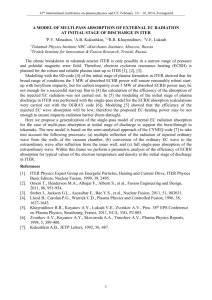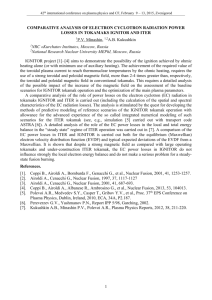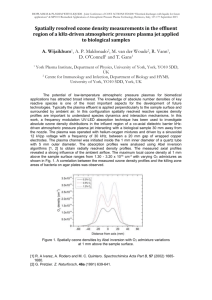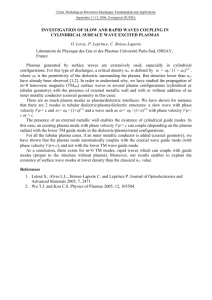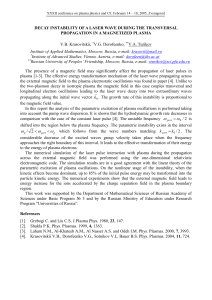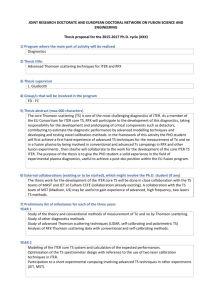Off-axis Current Drive and Plasma Heating by NBI, Helicons, LH and
advertisement
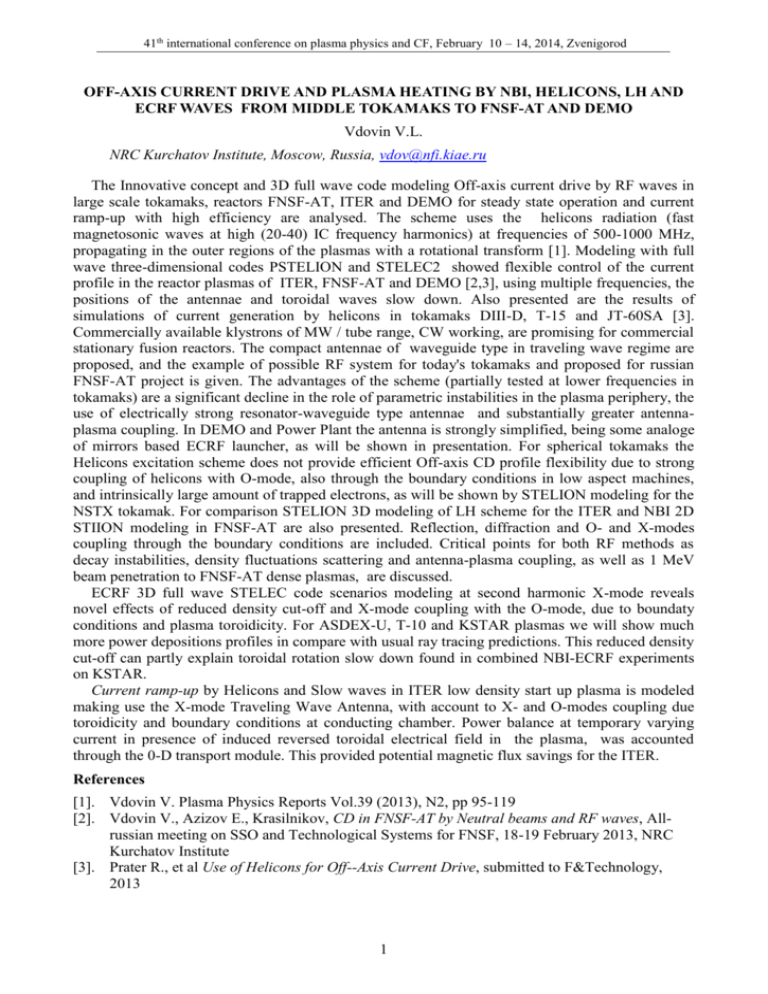
41th international conference on plasma physics and CF, February 10 – 14, 2014, Zvenigorod OFF-AXIS CURRENT DRIVE AND PLASMA HEATING BY NBI, HELICONS, LH AND ECRF WAVES FROM MIDDLE TOKAMAKS TO FNSF-AT AND DEMO Vdovin V.L. NRC Kurchatov Institute, Moscow, Russia, vdov@nfi.kiae.ru The Innovative concept and 3D full wave code modeling Off-axis current drive by RF waves in large scale tokamaks, reactors FNSF-AT, ITER and DEMO for steady state operation and current ramp-up with high efficiency are analysed. The scheme uses the helicons radiation (fast magnetosonic waves at high (20-40) IC frequency harmonics) at frequencies of 500-1000 MHz, propagating in the outer regions of the plasmas with a rotational transform [1]. Modeling with full wave three-dimensional codes PSTELION and STELEC2 showed flexible control of the current profile in the reactor plasmas of ITER, FNSF-AT and DEMO [2,3], using multiple frequencies, the positions of the antennae and toroidal waves slow down. Also presented are the results of simulations of current generation by helicons in tokamaks DIII-D, T-15 and JT-60SA [3]. Commercially available klystrons of MW / tube range, CW working, are promising for commercial stationary fusion reactors. The compact antennae of waveguide type in traveling wave regime are proposed, and the example of possible RF system for today's tokamaks and proposed for russian FNSF-AT project is given. The advantages of the scheme (partially tested at lower frequencies in tokamaks) are a significant decline in the role of parametric instabilities in the plasma periphery, the use of electrically strong resonator-waveguide type antennae and substantially greater antennaplasma coupling. In DEMO and Power Plant the antenna is strongly simplified, being some analoge of mirrors based ECRF launcher, as will be shown in presentation. For spherical tokamaks the Helicons excitation scheme does not provide efficient Off-axis CD profile flexibility due to strong coupling of helicons with O-mode, also through the boundary conditions in low aspect machines, and intrinsically large amount of trapped electrons, as will be shown by STELION modeling for the NSTX tokamak. For comparison STELION 3D modeling of LH scheme for the ITER and NBI 2D STIION modeling in FNSF-AT are also presented. Reflection, diffraction and O- and X-modes coupling through the boundary conditions are included. Critical points for both RF methods as decay instabilities, density fluctuations scattering and antenna-plasma coupling, as well as 1 MeV beam penetration to FNSF-AT dense plasmas, are discussed. ECRF 3D full wave STELEC code scenarios modeling at second harmonic X-mode reveals novel effects of reduced density cut-off and X-mode coupling with the O-mode, due to boundaty conditions and plasma toroidicity. For ASDEX-U, T-10 and KSTAR plasmas we will show much more power depositions profiles in compare with usual ray tracing predictions. This reduced density cut-off can partly explain toroidal rotation slow down found in combined NBI-ECRF experiments on KSTAR. Current ramp-up by Helicons and Slow waves in ITER low density start up plasma is modeled making use the X-mode Traveling Wave Antenna, with account to X- and O-modes coupling due toroidicity and boundary conditions at conducting chamber. Power balance at temporary varying current in presence of induced reversed toroidal electrical field in the plasma, was accounted through the 0-D transport module. This provided potential magnetic flux savings for the ITER. References [1]. Vdovin V. Plasma Physics Reports Vol.39 (2013), N2, pp 95-119 [2]. Vdovin V., Azizov E., Krasilnikov, CD in FNSF-AT by Neutral beams and RF waves, Allrussian meeting on SSO and Technological Systems for FNSF, 18-19 February 2013, NRC Kurchatov Institute [3]. Prater R., et al Use of Helicons for Off--Axis Current Drive, submitted to F&Technology, 2013 1
